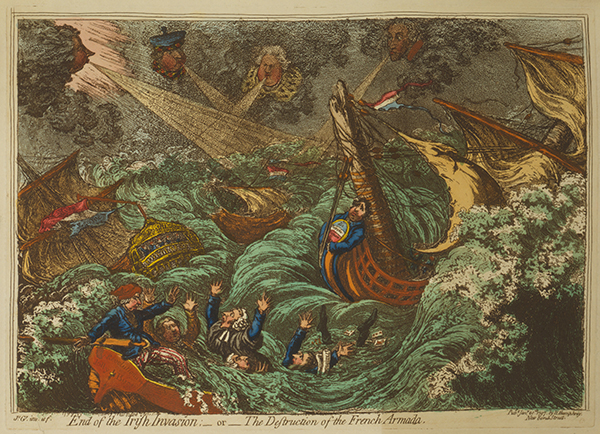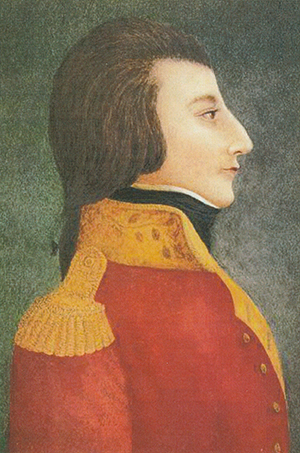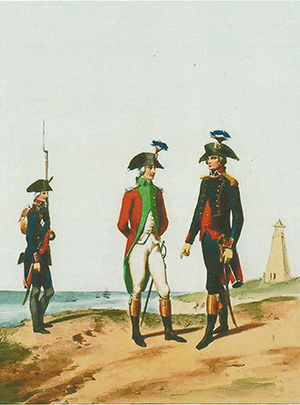‘Close enough to toss a ship’s biscuit ashore’—the French fleet at Bantry Bay, 1796
Published in 18th–19th - Century History, Features, Issue 6 (November/December 2016), Volume 24IN 1796 A LARGE FRENCH INVASION FLEET SLIPPED PAST THE ROYAL NAVY AND MOORED OFF THE SOUTH-WEST COAST OF IRELAND AT BANTRY BAY. BATTERED BY STORMS, THE FRENCH TROOPS WERE UNABLE TO LAND AND RETURNED TO FRANCE. ‘WE WERE CLOSE ENOUGH TO TOSS A SHIP’S BISCUIT ASHORE’, WROTE WOLFE TONE BITTERLY IN HIS DIARY OF THE FAILED MISSION.
By Stephen McGarry
France and England had been at war since 1793 and the First French Republic contemplated an invasion of Ireland, believing that Britain’s naval superiority would be reduced by the loss of Ireland. The Irish revolutionary organisation the Society of United Irishmen, which aimed to bring about an independent Irish republic, was driven underground in 1794. The following year Theobald Wolfe Tone fled to France and lobbied for French support for an invasion of Ireland. He argued that Ireland was the least defensible part of the British Isles and he was fortunate to find a willing ally in the acclaimed Anglophobic general Lazare Hoche. The French recovered faded naval charts written in parchment from their archives, some dating back to the mid-seventeenth century, and dusted them off as they gamely considered the proposal. ‘To detach Ireland from England is to reduce England to a second-rate power, and take from it much of its maritime superiority,’ concluded one of the French war ministers as he gave the go-ahead. ‘There is little point in elaborating on the advantage to France that Irish independence would bring.’
Dogged by delays
L’Expédition d’Irlande, due to depart in September 1796, was dogged by delays. But by December a 43-ship fleet, comprising seventeen ships of the line, thirteen frigates, corvettes and transport ships, commanded by Vice-Admiral Morand de Galles, together with 13,975 veteran troops under General Lazare Hoche, stood ready at the Atlantic seaport of Brest in Brittany. On the mild morning of 16 December, the signal was given to ‘heave short’, as the ships’ cables were pulled short over their anchors; two hours later anchors were weighed and the fleet cleared port. A number of ships collided with each other as they sailed out, indicative of poor seamanship, which many saw as a bad omen.
Vice-Admiral Morand, aware of the Royal Navy lurking off the Breton coast, intended to sail south at night through a dangerous narrow channel, the Raz de Seine. This was a decoy manoeuvre to fool the Royal Navy into believing that his destination was Portugal. The Raz, however, proved to be too dangerous to navigate in the darkness; the Séduisant (74 guns) ran aground off the rocks. Morand instead ordered the ships in the rear to head westerly towards the Iroise Channel, thus splitting the fleet.
On the morning of 19 December, seventeen ships, including Tone’s, the man-o’-war Indomptable (80 guns), waited as the remaining fleet emerged through the heavy fog. A number of ships were missing; crucially, there was no sign of the flagship Fraternité (32 guns), carrying the two commanders-in-chief, Morand and Hoche. She had been blown off course by strong winds, only to return to France. The fleet separated again but joined up and continued cruising along the Irish coast. When nine nautical miles off Cape Clear, Tone caught sight of his native land and saw patches of snow on the mountains, and later on a number of castles scattered in the countryside.
Sealed orders opened
They arrived at the rendezvous point off Mizen Head on 21 December and opened their sealed orders, written by Morand and Hoche, containing the location of the proposed landing—Bantry Bay. They were to disembark there and march on Cork, join forces with the United Irishmen and their supporters and push northwards. (This was the second major force dispatched to Bantry since the Spanish Armada. During the Jacobite War, in 1689, the French navy engaged an English fleet and landed there with supplies of arms.)
The fleet coasted close to Mizen before standing out to sea for their approach to Bantry Bay. French fortunes changed when off Duresy Island they picked up a number of Irish pilots, who had sailed out in a hooker in the belief that the French ships were British. Nevertheless, they agreed to guide them into the bay. The French ships, pitching and rolling, tacked for hours in the strong easterly head winds but made little progress as they navigated Bantry’s natural harbour, with only fifteen ships, including Tone’s and the Immortalité (40 guns), carrying General Emmanuel de Grouchy, the second-in-command, entering the bay. The frigate Résolue (32 guns) collided with another ship and launched a longboat to tow her, but it was blown ashore and taken as a prize, along with Lt. Prointeau and his crew. Meanwhile, the ships outside the bay’s mouth dropped anchor when the gale developed into a storm that lasted two days, preventing their passage into the bay; others were blown back into the open sea.

Above: The End of the Irish Invasion; — or — the Destruction of the French Armada (1797) by James Gallray.
General de Grouchy convened a council of war, intending to capture Cork with the remaining 6,500 troops and to follow Tone’s plan for an amphibious landing in Sligo Bay with a regiment of the Legion des Francs, a company of light artillery and as many officers, stores and arms as they could spare. An order of battle was briskly drawn up.

Below: A longboat from the frigate Résolue, blown ashore when she came to the assistance of another ship, still sporting her French colours after 220 years, now on display in the National Museum, Collins Barracks.
‘We have nothing but the arms in our hands,’ Tone wrote with gusto in his diary, ‘the clothes on our back, and a good courage, but that is sufficient.’

Above: Theobald Wolfe Tone—wrote in his diary that he did not have ‘the good fortune to be killed in the action’.
A heavy gale, however, blew on Christmas Eve night. Tone’s ship remained rolling heavily in the bay, the wind roaring through the rigging as the ship creaked and groaned, the waves crashing violently against her hull. Tone, unable to sleep, got out of his hanging ‘cot’, put on his boots and greatcoat, and paced the Indomptable’s quarterdeck. He worried that the strong easterly gales blowing from the shore, accompanied by snow, would not only make it impossible to land but also prevent them from posting a frigate at the harbour’s mouth to warn of the arrival of any English ships. Tone was a lawyer and knew that he was committing high treason; if captured, he surmised, he would be subject to a public trial and then half-hanged and disembowelled as a warning to others—unless, of course, he had the good fortune to be killed in action.

Above: Uniforms of the Armée d’Irlande—an Irish officer (centre), with a French marine private (left) and officer (right).
In the evening of Christmas Day, de Grouchy’s frigate suddenly emerged out of the stormy darkness and scudded at speed under the quarterdeck of Tone’s ship, an officer shouting through a semaphone ‘with orders to cut our cable and put to sea instantly’. Was this a ruse de guerre, Tone wrote in disbelief? Perhaps it was an English frigate masquerading as a French ship? But de Grouchy’s ship left the bay, ‘and the fog is so thick’, wrote Tone in disgust, ‘that we cannot see a ship’s length, we are left without admiral or general’.
Strong easterly and south-easterly gale-force winds continued to blow the next day, battering the fleet. The Indomptable dropped her fore and aft anchors to keep her position but they still dragged on the sea floor, nearly blowing the ship onto the rocks. The Révolution (74 guns) rocked and swayed violently under the strain as another heavy sea swell lifted it, could hold no longer, cut her cable and put to sea, followed swiftly by several others. There were now only seven men-o’-war and one frigate in the bay. As the winds were now against the fleet moving up towards Sligo, Major-General Oliver Harty, as the most senior officer present, convened a council of war; they agreed to sail further up the coast with just over 4,000 men, two four-pounders and ammunition, and wait for the rest of the fleet.
The ships cruised along the coast and moored at the mouth of the Shannon, until a ‘dreadful hurricane’ blew up on 28 December, battering and nearly sinking Tone’s ship. The huge waves crested and crashed over the decks, plunging the cabins into darkness and filling them with water up to their waists. The following day, the signal was given for the nine remaining ships to steer for France. The frigate Scévola (44 guns) foundered, but luckily all 820 men on board were rescued by the Révolution; the demasted frigate Impatiente (40 guns) was wrecked off Crookhaven with all hands, save for seven, while Surveilance was leaking water and was scuttled. Tone, desperately disappointed, spent the day seasick in his cabin, his ship arriving back in Brest on 1 January, ‘astonished that we hadn’t seen an English ship, going or coming back’.
Only 35 ships returned to Brest, many badly damaged, with over 1,500 drowned and 2,000 captured. De Grouchy should not have split the fleet by changing his orders as the fleet travelled through the Raz. Hoche should have boarded a three-master, not a smaller frigate, and if he had remained with the fleet he would have acted more decisively than his second-in-command, Morand. Of course, the strong easterly gales off the tempestuous south-west Irish coast didn’t help; neither did poor French seamanship. In 1798 the French tried again and landed an expeditionary force on the west coast of Ireland, which also ended in failure. Tone was aboard a French ship intercepted by the Royal Navy off the Donegal coast and captured. He fought gallantly, commanding a gun battery in the action, but alas had not ‘the good fortune to be killed in the action’, as he wrote two years previously in his diary. He was brought to Dublin, found guilty of treason and sentenced to be hanged, cheating the hangman’s noose by cutting his own throat.
Stephen McGarry is the author of Irish Brigades abroad: from Wild Geese to the Napoleonic Wars (Dublin, 2013).
Read More:
Crown forces
Franco-Irish forces
FURTHER READING
J.A. Murphy (ed.), The French are in the Bay: the expedition to Bantry Bay 1796 (Cork, 1997).
T. Bartlett (ed.), Life of Theobald Wolfe Tone: memoirs, journals and political writings, compiled and arranged by William T.W. Tone, 1826 (Dublin, 1998).
















